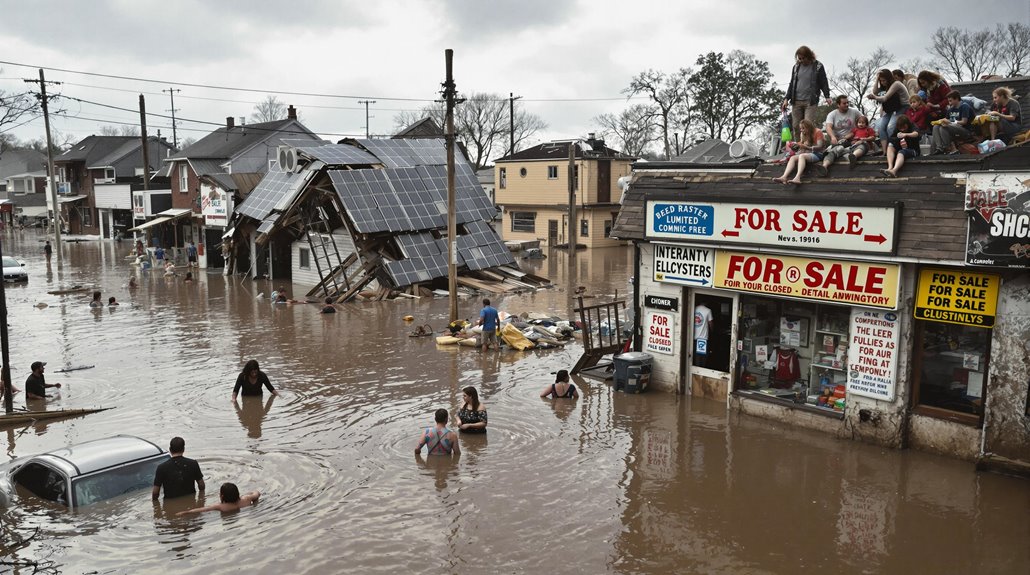Flooding causes widespread destruction, resulting in physical damage to infrastructure and property, including structural collapse and costly repairs. Environmental and health concerns arise from contaminated water sources, disease outbreaks, and soil erosion. Economic disruption impacts communities and businesses, with significant losses and compromised supply chains. Emotional trauma and psychological distress also occur, affecting long-term mental health. A deeper examination of the consequences of flooding reveals the complexity of recovery efforts and the importance of proactive preparedness strategies.
Key Takeaways
- Severe physical damage to infrastructure and property leads to significant economic losses due to costly repairs and structural collapse.
- Floodwaters can contaminate water sources, threatening water quality and exposing individuals to pathogens and contaminants that lead to disease outbreaks.
- Flooding disrupts daily life, causes loss of belongings, and increases stress and anxiety, ultimately affecting the mental health of those affected.
- Significant business disruption results in lost revenue, damaged infrastructure, and compromised supply chains, leading to substantial financial losses.
- Long-term consequences of flooding impact community resilience, economic stability, and sustainability if effective preparedness and mitigation strategies are not implemented.
Physical Damage to Infrastructure and Property
Floods inflict severe physical damage to infrastructure and property, resulting in significant economic losses for individuals, businesses, and governments. The damage to buildings, roads, and bridges can be extensive, with the potential for structural collapse or damage to foundations. Additionally, the floodwaters can compromise electrical and plumbing systems, requiring costly repairs. Building codes play an essential role in mitigating the impact of floods, as structures constructed with flood-resistant materials can better withstand the forces of water. In the aftermath of floods, insurance claims are typically filed to cover the cost of repairs, which can help alleviate some of the financial burdens imposed on affected parties. Effective building codes and adequate insurance coverage can reduce the economic impact of floods. With only 27% of homeowners in designated flood zones carrying flood insurance, many property owners face devastating uninsured losses when flooding occurs.
Environmental and Health Concerns

The aftermath of a flood is often marked by a complex web of environmental and health concerns, which can be just as devastating as the initial physical damage. Floodwaters can contaminate water sources, posing a significant threat to water quality. This can lead to disease outbreaks, as individuals are exposed to pathogens and other contaminants. The table below highlights some of the key environmental and health concerns associated with flooding: In addition to water contamination, floods can cause substantial infrastructure damage, including to sewage systems, which exacerbates health risks in affected communities. The resulting water damage explained in detail reveals how structural deterioration can lead to mold growth and air quality issues, further endangering residents’ health. Moreover, the displacement of populations due to flooding can create long-term mental health challenges, as individuals grapple with the loss of homes and livelihoods in the aftermath of the disaster.
| Environmental Concerns | Health Concerns | Consequences |
|---|---|---|
| Water pollution | Waterborne diseases | Cholera outbreaks |
| Soil erosion | Respiratory problems | Increased morbidity |
| Habitat disruption | Mental health issues | Long-term psychological trauma |
| Loss of biodiversity | Malnutrition | Increased mortality rates |
Effective management of floodwaters and subsequent environmental and health concerns is essential to mitigating the overall impact of flooding.
Economic Impact on Communities and Businesses

Numerous communities and businesses are severely affected by the economic repercussions of flooding, which can be far-reaching and multifaceted. The immediate effects of flooding often involve significant business disruption, resulting in lost revenue, damaged infrastructure, and compromised supply chains. Additionally, the destruction of property and assets can lead to substantial financial losses, impacting both individual businesses and the broader community. However, community resilience plays an essential role in mitigating these economic impacts. By implementing effective disaster recovery plans and fostering collaborative relationships, communities can work towards revitalizing local economies and supporting affected businesses. Ultimately, understanding the economic implications of flooding is vital for developing strategies that promote resilience and facilitate recovery in the face of these devastating events.
Emotional Trauma and Psychological Effects

Beyond the tangible economic losses inflicted by flooding, a more insidious and long-lasting impact can be observed in the profound emotional trauma and psychological distress experienced by individuals and communities. The disruption of daily life, loss of personal belongings, and forced displacement can lead to increased stress, anxiety, and depression. Moreover, the experience of flooding can also trigger pre-existing mental health conditions, exacerbating symptoms and hindering recovery. Effective trauma recovery requires a thorough approach that incorporates mental health support, social services, and community-based initiatives. By acknowledging the psychological effects of flooding, individuals and communities can better cope with the aftermath and rebuild their lives, fostering resilience and promoting long-term mental health. This enables affected populations to reconnect with their communities and surroundings.
Long-Term Consequences and Recovery Efforts

Recovery from flooding is a protracted and multifaceted process, influenced by an array of factors including the severity of the event, the efficacy of disaster response and relief efforts, and the resilience and adaptability of affected communities. The long-term consequences of flooding can be far-reaching, with impacts on community resilience, economic stability, and environmental sustainability. Effective flood preparedness and mitigation strategies are essential in minimizing the severity of flood-related damages. A thorough recovery plan should incorporate measures to enhance community resilience, including the restoration of critical infrastructure, the provision of support services for affected residents, and the implementation of flood-risk reduction measures. By adopting a proactive approach to flood preparedness and recovery, communities can reduce the likelihood and impact of future flooding events.








